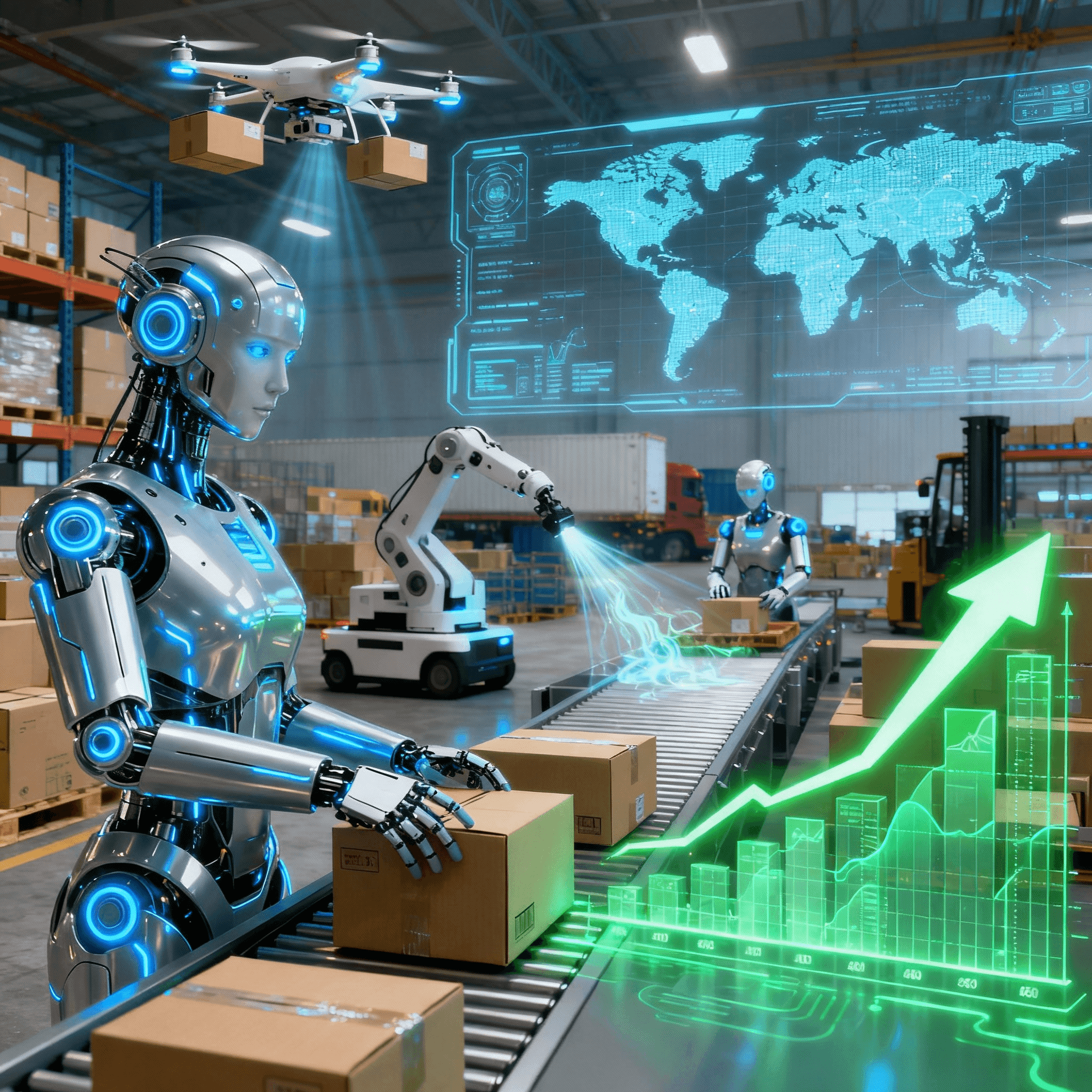AI Agent Investments: Transforming Logistics P&L Performance
Thursday, 9 Oct 2025
|
Building the Business Case: AI Agent Investments That Transform Logistics P&L Performance
In today’s logistics landscape, the difference between leading and lagging companies increasingly comes down to one factor: how effectively they leverage AI.
Artificial Intelligence (AI) agents—autonomous digital systems that can analyze data, make decisions, and execute tasks—are quickly becoming a game changer for logistics organizations. From optimizing routes and managing warehouse operations to forecasting demand and improving customer satisfaction, AI agents are reshaping the Profit and Loss (P&L) dynamics of logistics firms.
For logistics executives—CEOs, CXOs, and COOs—the question is no longer “Should we invest in AI?” but “How can we build a business case for AI agent investments that deliver measurable ROI?”
This article explores how AI agents can significantly impact your P&L, the key investment areas that yield the strongest returns, and how to strategically deploy AI for maximum value.
The Logistics P&L Challenge: Efficiency vs. Profitability
In logistics, profitability often hinges on operational efficiency. Rising fuel prices, labor shortages, fluctuating demand, and increasing customer expectations have created a perfect storm of cost pressures.
Executives face a balancing act between maintaining high service quality and managing costs across a complex, global network. Traditional optimization strategies—manual planning, siloed systems, and reactive decision-making—are no longer sufficient.
Here’s where AI agents create a new equation for profitability: by automating decisions, predicting disruptions, and continuously optimizing operations, they enable logistics companies to grow margins while maintaining service excellence.
What Are AI Agents and Why They Matter for Logistics
AI agents are intelligent software systems capable of perceiving their environment, reasoning about data, and taking autonomous actions toward a specific goal. In logistics, these agents can:
- Continuously monitor supply chain performance
- Predict risks (e.g., weather disruptions, traffic, demand spikes)
- Recommend or execute real-time actions (rerouting, reallocation, etc.)
Unlike traditional automation systems that execute predefined tasks, AI agents learn, adapt, and optimize continuously. They integrate seamlessly with existing infrastructure, enhancing decision-making without requiring full system overhauls.
In short: AI agents turn reactive logistics operations into proactive, self-optimizing ecosystems.
The Business Case: How AI Agents Directly Impact P&L Performance
Investing in AI agents isn’t just a technological upgrade—it’s a strategic lever for P&L transformation. Let’s break down the key areas where AI delivers measurable value.
1. Revenue Growth: Enhancing Service and Customer Retention
Customer satisfaction directly impacts revenue—and AI agents excel at improving service reliability, transparency, and speed.
- Predictive ETA Accuracy: AI agents use real-time data to deliver highly accurate delivery estimates, reducing missed SLAs and improving trust.
- Dynamic Service Optimization: AI continuously adjusts delivery schedules, resources, and routes to ensure faster, more reliable delivery experiences.
- Personalized Customer Communication: Through AI-driven chatbots and predictive updates, customers receive proactive notifications about delays or alternative delivery windows.
P&L Impact:
Improved customer satisfaction reduces churn, boosts retention, and enhances brand reputation—translating directly into higher top-line growth.
Real-World Example:
Amazon Logistics uses AI-driven forecasting and predictive routing to achieve near-perfect delivery times. The company’s continuous reinvestment in AI-enabled service improvements has been instrumental in retaining Prime customers, who account for a significant portion of Amazon’s logistics revenue.
2. Cost Reduction: Operational Efficiency at Scale
AI agents identify inefficiencies across logistics processes—fuel usage, idle time, warehouse bottlenecks—and implement corrective actions in real-time.
- Dynamic Route Optimization: AI agents like UPS’s ORION system have already saved millions of gallons of fuel by recalculating optimal routes daily.
- Warehouse Automation: AI agents coordinate autonomous robots, reducing labor costs while improving pick-and-pack accuracy.
- Demand Forecasting: AI predicts inventory needs, preventing both stockouts and overstocking that tie up working capital.
P&L Impact:
Operational efficiency improvements lead directly to cost reductions across transportation, labor, and inventory holding—improving margins by up to 10–15%.
Real-World Example:
DHL’s Resilience360 AI platform proactively identifies potential supply chain disruptions, helping the company reallocate resources before issues occur. The result? Fewer delays, reduced waste, and lower operating costs.
3. Margin Optimization: Smarter Pricing and Procurement
AI agents also enhance pricing and procurement decisions—two critical levers for profitability.
- Dynamic Pricing: AI adjusts freight rates in real-time based on market demand, fuel prices, and capacity availability.
- Supplier Performance Monitoring: AI continuously assesses supplier reliability, enabling logistics leaders to make smarter procurement choices.
- Predictive Bidding: For freight brokers and carriers, AI optimizes bid strategies to maximize win rates and profit margins.
P&L Impact:
Smarter pricing and procurement reduce costs while maximizing revenue per shipment, directly improving contribution margins.
Real-World Example:
Maersk leverages AI for dynamic freight pricing, helping the company match supply with fluctuating demand while maintaining profitability—even during market volatility.
4. Risk Mitigation: Predicting and Preventing Disruptions
Delays, weather events, and geopolitical disruptions can wreak havoc on logistics performance and profitability. AI agents can detect potential risks early and take preventive actions.
- Predictive Disruption Alerts: AI agents analyze weather data, port congestion, and customs delays to forecast potential disruptions.
- Proactive Route Reallocation: When risks are detected, AI agents automatically reroute shipments or adjust warehouse allocations to prevent losses.
- Continuous Learning: AI systems refine their models with every disruption, improving future resilience.
P&L Impact:
Reducing disruption-related costs protects profit margins and enhances customer confidence—critical for long-term growth.
Real-World Example:
FedEx employs AI-driven predictive models to anticipate delays from severe weather or air traffic congestion. This allows rerouting and resource reallocation, minimizing revenue loss from service disruptions.
Strategic Steps to Build the Business Case for AI Agents
Start with a High-Impact Use Case
Begin with a pilot project that directly affects your P&L—such as route optimization or predictive maintenance. This builds credibility and demonstrates measurable ROI early.
Integrate AI with Existing Infrastructure
AI agents work best when integrated with ERP, TMS, and WMS systems. Focus on data interoperability rather than full replacements.
Prioritize Data Quality and Governance
AI performance depends on accurate, timely data. Establish strong data management protocols before scaling AI systems.
Align AI Initiatives with Business KPIs
Every AI project should tie directly to P&L metrics—cost reduction, revenue growth, or margin improvement.
Communicate Value Internally
Use dashboards and visual analytics to show the financial benefits of AI investments across departments.
Conclusion: AI Agents Are Profitability Multipliers for Logistics
AI agents are not just digital assistants—they are strategic assets that drive measurable improvements across logistics operations. From cost reduction and risk mitigation to enhanced customer experiences, AI investments can transform your P&L in ways that traditional automation simply cannot.
For logistics executives, the time to act is now. Those who build a strong business case for AI agent investments will not only improve profitability but also future proof their operations against evolving market pressures.
Next Steps: Book a Demo with Debales AI!
Ready to see how AI agents can transform your logistics P&L? Book a personalized demo with Debales AI to explore intelligent solutions designed to enhance efficiency, reduce costs, and drive growth.
Suggested Posts:
Explore more insights on AI in logistics:


